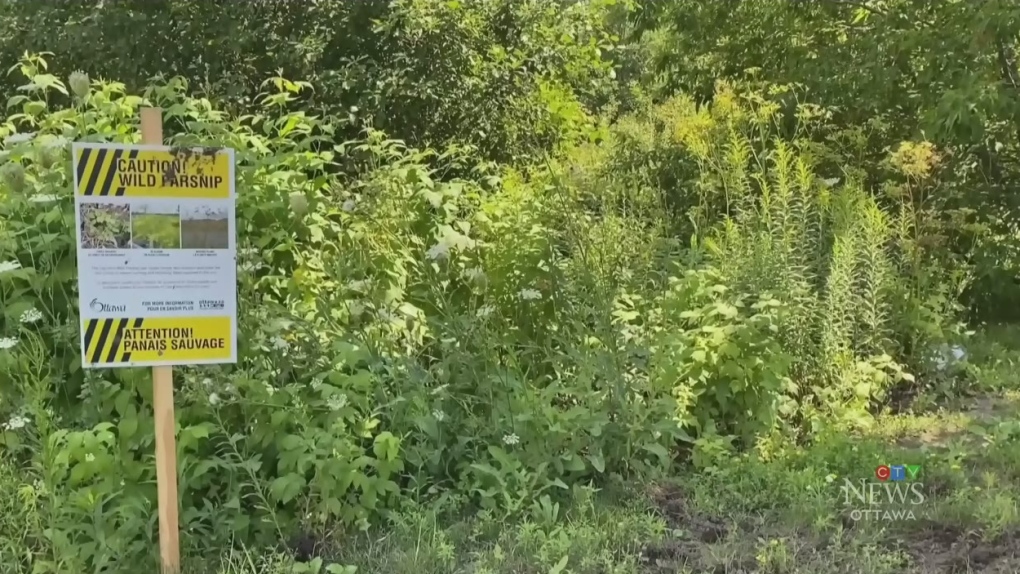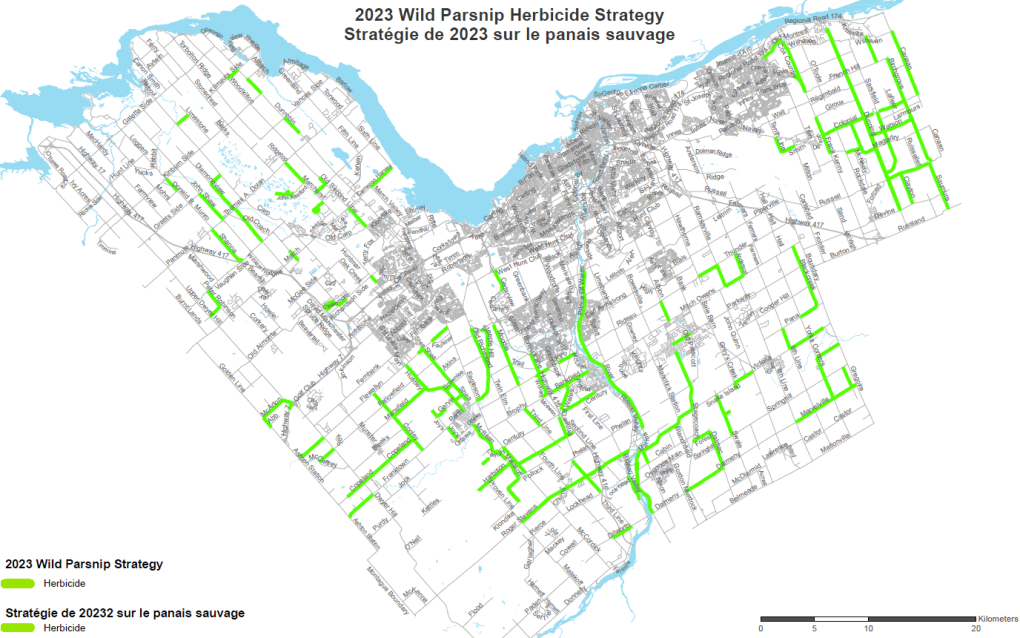Ottawa to begin spraying and mowing wild parsnip in suburban and rural areas

The city of Ottawa will begin spraying and mowing roadsides, pathways and parks this week to deal with wild parsnip, the invasive plant that can cause skin and eye irritation and make the skin prone to burning and blistering.
Approximately 650 lane kilometres of roadsides and pathways and over 200 park locations in suburban and rural areas will be treated with herbicides and mowed over the next few weeks and months.
"The goal is to reduce the growth of wild parsnip in highly infested areas while ensuring that environmentally sensitive areas and public safety are not adversely impacted," Allison Wilson, manager of technical operations with Public Works, said in a memo to Council.
In addition to the application of herbicides in highly infected areas, staff will continue, "mowing operations, adjusting frequency and timing to best coincide with herbicide applications."
Wilson says a "Notice of Herbicide Use" advertisement will appear in local newspapers one week prior to the start of spraying in public locations. Signs will also be posted every 100 metres along pathways and parks.
The Wild Parsnip Program will begin on Monday, with spraying in city parks to begin on June 6, weather permitting. Roadside grass cutting will also begin in early June.
The city will spend $298,000 to deal with wild parsnip this spring and summer.
Wild parsnip has been identified as a noxious weed in Ontario since Jan. 1, 2015.
Rural property owners can ask the city not to spray the areas adjacent to their property.
"Should a resident opt-out of the program, it will become their responsibility to manage any wild parsnip infestation adjacent to their property, as required by the Weed Control Act, 1990," Wilson says.
 The city of Ottawa released a map outlining where herbicides will be sprayed along roadsides/pathways and parkland to deal with wild parsnip. (City of Ottawa/memo)
The city of Ottawa released a map outlining where herbicides will be sprayed along roadsides/pathways and parkland to deal with wild parsnip. (City of Ottawa/memo)
Identifying wild parsnip
Wild parsnip is a highly branched plant, with hollow green stems, according to the city of Ottawa's website.
"It has two growth stages: non-flowering leafy rosettes at ground level and 0.5 to 1.5 metre-tall flowering plants."
The city outlines the stages of growth for wild parsnip on its website:
- Early growth: In the first year of growth, low-growing non-flowering rosettes of leaves form with a cluster of spindly, compound leaves that resemble celery leaves.
- In bloom: When wild parsnip is in bloom, usually in the second and third-year plants have tall, branched yellow flowering stalks that usually bloom in early June to late July.
- Mature plant: Starting in August the blooming plant will begin to turn brown and the leaves and stems will begin to dry up. This means that the toxic sap from the plant will also begin to dry up, and contact with the plant is less likely to cause a reaction.
How to avoid the plant
The city of Ottawa offers the following tips to avoid wild parsnip on pathways and in parks:
- It is recommended that the public stay on the groomed areas of parks, roadsides and pathways where there are less instances of wild parsnip.
- When working around wild parsnip or when walking through dense vegetation, wear goggles, gloves, long pants and long-sleeved shirts.
- Children should be reminded not to pick wild flowers
- If you are exposed to the plant sap, wash the contaminated area(s) thoroughly as soon as possible, and seek medical attention if skin irritation occurs
CTVNews.ca Top Stories

B.C. tenants evicted for landlord's use after refusing large rent increase to take over neighbouring suite
Ashley Dickey and her mother rented part of the same Coquitlam duplex in three different decades under three different landlords.
Mountain guide dies after falling into a crevasse in Banff National Park
A man who fell into a crevasse while leading a backcountry ski group deep in the Canadian Rockies has died.
Expert warns of food consumption habits amid rising prices
A new survey by Dalhousie University's Agri-Food Analytics Lab asked Canadians about their food consumption habits amid rising prices.
MPP Sarah Jama asked to leave Ontario legislature for wearing keffiyeh
MPP Sarah Jama was asked to leave the Legislative Assembly of Ontario by House Speaker Ted Arnott on Thursday for wearing a keffiyeh, a garment which has been banned at Queen’s Park.
Charlie Woods, son of Tiger, shoots 81 in U.S. Open qualifier
Charlie Woods failed to advance in a U.S. Open local qualifying event Thursday, shooting a 9-over 81 at Legacy Golf & Tennis Club.
Ex-tabloid publisher testifies he scooped up possibly damaging tales to shield his old friend Trump
As Donald Trump was running for president in 2016, his old friend at the National Enquirer was scooping up potentially damaging stories about the candidate and paying out tens of thousands of dollars to keep them from the public eye.
Here's why provinces aren't following Saskatchewan's lead on the carbon tax home heating fight
After Prime Minister Justin Trudeau said the federal government would still send Canada Carbon Rebate cheques to Saskatchewan residents, despite Saskatchewan Premier Scott Moe's decision to stop collecting the carbon tax on natural gas or home heating, questions were raised about whether other provinces would follow suit. CTV News reached out across the country and here's what we found out.
Montreal actress calls Weinstein ruling 'discouraging' but not surprising
A Montreal actress, who has previously detailed incidents she had with disgraced Hollywood producer Harvey Weinstein, says a New York Court of Appeals decision overturning his 2020 rape conviction is 'discouraging' but not surprising.
Caleb Williams, Jayden Daniels and Drake Maye make it four NFL drafts with quarterbacks going 1-3
Caleb Williams is heading to the Windy City, aiming to become the franchise quarterback Chicago has sought for decades.
































